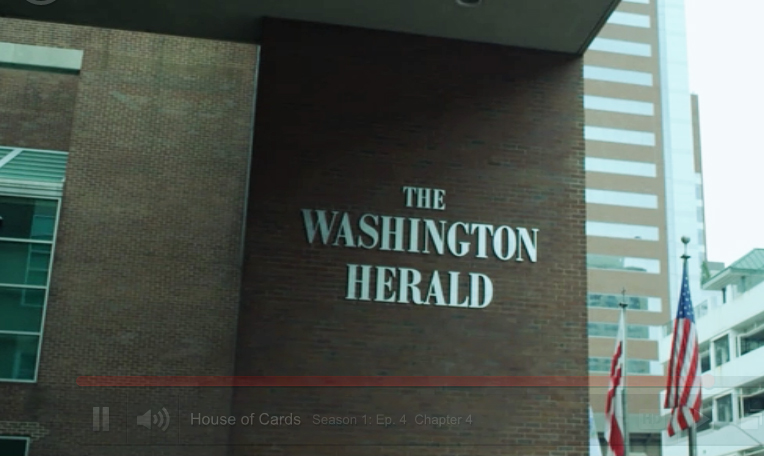“House of Cards” was filmed in part at the Baltimore Sun’s building, where producers built the newsroom for the fictional Washington Herald (not to be confused with The Washington Globe from the 2009 film “State of Play” or the “Washington Capital” in the thriller “The Rules of the Game” by former Washington Post Executive Editor Len Downie Jr.).
Last June Sun reporter David Zurawik wrote he hadn’t been able to see the sets — which weren’t in the Sun’s newsroom — but he could see the Herald’s sign outside.

Wednesday, when I walked up the front steps of The Sun building on Calvert Street, I saw big letters outside reading “The Washington Herald.” That’s the fictional paper in this version of “House of Cards.” Of course, I could guess the reason for the new signage, but in this era of media tumult, I don’t need any artificial change; there’s plenty of the real stuff.
I share some of this because I am in a bit of an awkward place, with the producers renting space and buying some privacy to do their work on Sun property — while I push for any access and information I can get.
Actress Constance Zimmer plays the Herald’s White House correspondent in “House of Cards.” She told The Hollywood Reporter she “saw the future of the newspaper industry on a daily basis” during filming. “Journalism is fading. It’s so sad … Newspapers are shutting down. We were filming in the Baltimore Sun’s building, and half of their offices were closed down. It’s very depressing.”
“The Wire”‘s producers also re-created the Baltimore Sun’s newsroom, Margaret Talbot reported in The New Yorker:
The Sun allowed its name to be used on “The Wire,” but stipulated that no current employees could appear in it; the newspaper’s offices have been re-created on the show’s hulking soundstage outside the city. This arrangement suited [creator David] Simon fine—he bitterly accepted a buyout offer from the paper in 1995, feeling that it was squandering talent under new management.
In an email, Simon said he didn’t know what happened to the set: “Probably sold off,” he writes. “Assets are liquidated after a set is wrapped.”
That happened with the Washington Post set in “All the President’s Men.” Timothy Noah’s first job in publishing was at “New West,” where he worked on the furniture from that set. The desks and chairs were “far too ugly to repurpose for Warners’ own studio offices,” Noah writes; in his newsroom the pieces were “modified by the drilling of holes through several desktops to allow for the insertion of Cinzano umbrellas (a fashion statement unthinkable in the real Post newsroom).”
Hollywood sets for television newsrooms are even more interesting, since they are usually sets that depict a set. Before “The Newsroom” premiered last year, HBO published a video about making its set. “Throw a satellite on top of the roof and we could broadcast,” star Jeff Daniels says.
“The Newsroom” is set in the recent past, so its set designers have plenty of visual source material to draw on. For the BBC series “The Hour,” which is set in the late 1950s, designer Eve Stewart was lucky to find old BBC gear in a BBC employee’s shed, she said in an interview:






